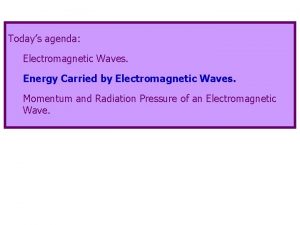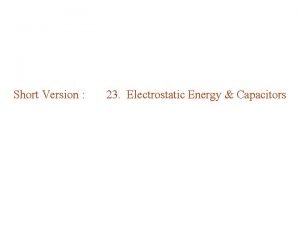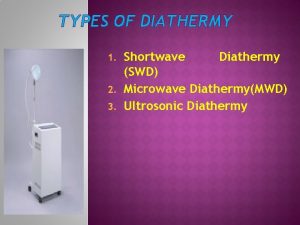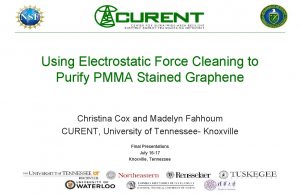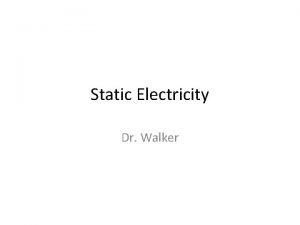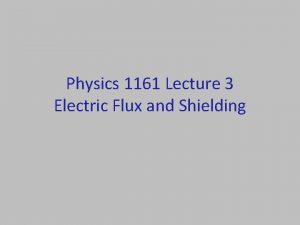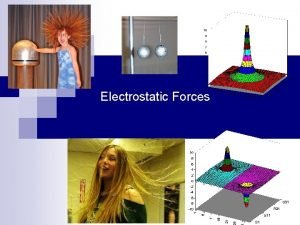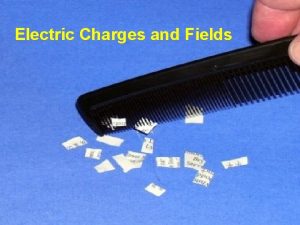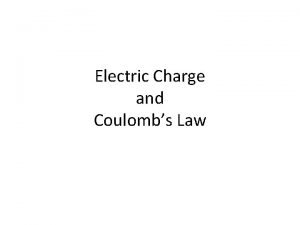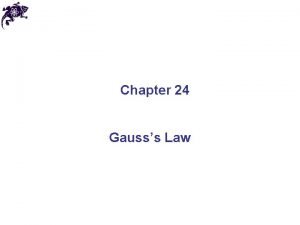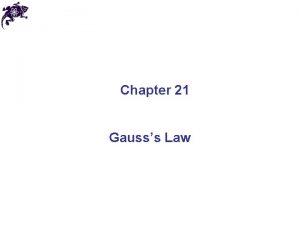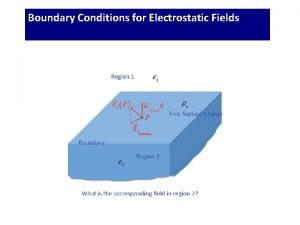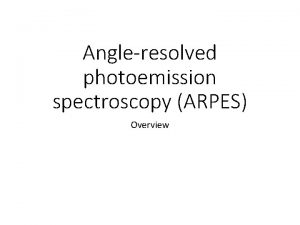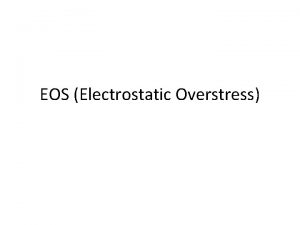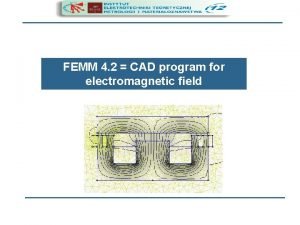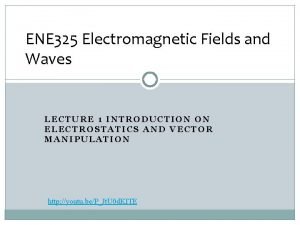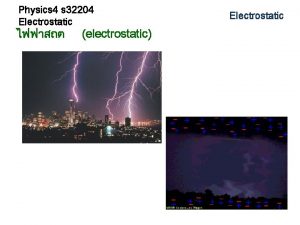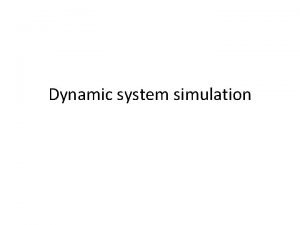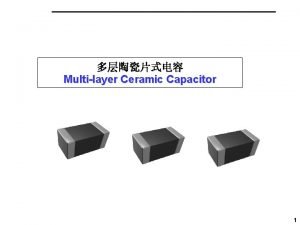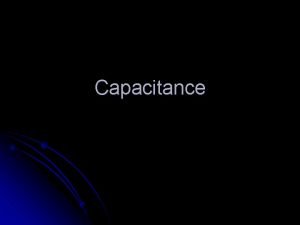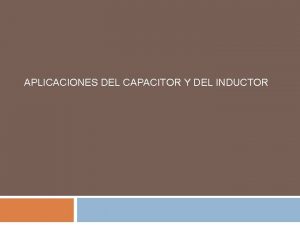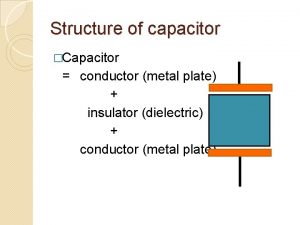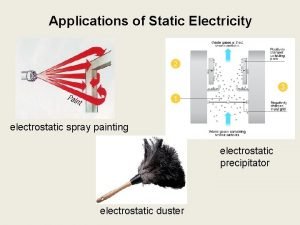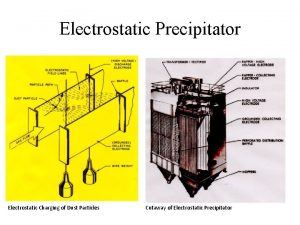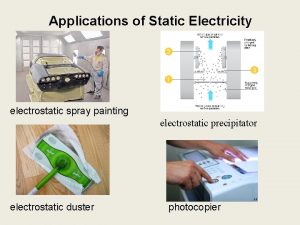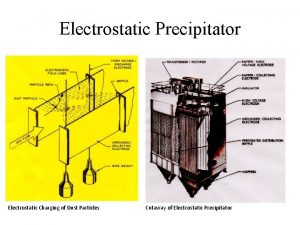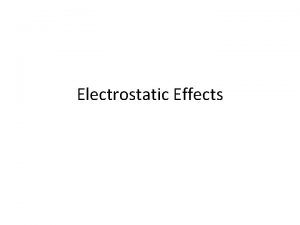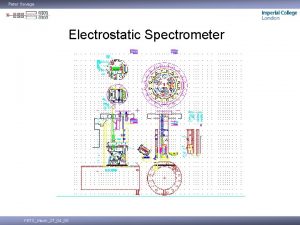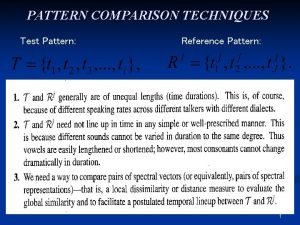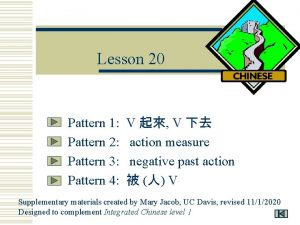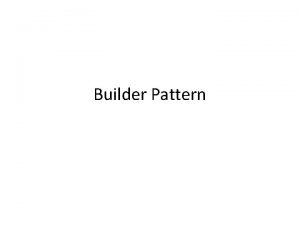Electrostatic principles Field pattern in a capacitor Field

























- Slides: 25

Electrostatic principles

Field pattern in a capacitor Field strength = V/d Volts per metre (voltage gradient)

Charging a capacitor Q = Qo(1 -e -t/RC) = CVb(1 -e -t/RC) Charge Current I = I 0 e –t/RC = (Vb/R) e –t/RC CR 3 CR 2 CR Time 4 CR

Discharging a capacitor Q = Qoe-t/CR Charge CR 3 CR 2 CR Time 4 CR

Charging a capacitor An RC network comprises an 6 μF capacitor and a 0. 4 MΩ resistor. When a 150 V d. c. supply is applied to the network, calculate: i) initial charging current ii) time constant iii) time taken for the p. d. across the capacitor to reach 100 V iv) current, and p. d. across the capacitor, 2 seconds after connecting the supply.

Charging a capacitor i) V/R = 150/(0. 4 x 106) = 375 μA ii) time constant = RC = (0. 4 x 106) x (6 x 10– 6) = 2. 4 Seconds

Charging a capacitor iii) v = V (1 -e -t/RC ). 100 = 150 (1 - e -t/2. 4). (100/150) - 1 = -e -t/2. 4 = -0. 33 e -t/2. 4 = 0. 33 Logn 0. 33 = -t/2. 4 -1. 1 = -t/2. 4 t = 1. 1 x 2. 4 = 2. 64 secs

Charging a capacitor • iv) voltage after 2 seconds. • v = 150 (1 - e- 2/2. 4). • 150 (1 - 0. 43) • =150 x. 56 • 84 volts

Charging a capacitor • current after 2 seconds i = Ie - t/2. 4. • Therefore I= (375 x 10– 6) x 0. 43) • = 155 x 10 -6 A

Instantaneous current • Instantaneous current, • I = C x dv/dt • If the voltage across a 4μF is changing at the rate 800 v/s the current flow is • 4 x 10 -6 x 800 • = 3. 2 x 10 -3 Amps • 3. 2 m. A

Deflection of an electron beam Anodes (+) ve ve Cathode (-) Centre line of beam deflecting plates Electrons are accelerated from the cathode through the anodes

Deflection of an electron beam Anodes (+) ve ve Cathode (-) Centre line of beam deflecting plates Electrons are accelerated from the cathode through the anodes

Deflection of an electron beam Anodes (+) ve ve Cathode (-) Centre line of beam deflecting plates An electron accelerated through a potential difference of 1 volt gains an electron-volt (e. V) of energy

Deflection of an electron beam Anodes (+) ve ve Cathode (-) Centre line of beam deflecting plates One e. V = 1. 6 x 10 -19 Joules (Charge on an electron = 1. 6 x 10 -19 coulombs)

Deflection of an electron beam ve Centre line of beam ve

Deflection of an electron beam ve Centre line of beam ve Charge on an electron q = 1. 6 x 10 -19 coulombs Force acting on the electron = q x potential gradient F = q x v/d

Deflection of an electron beam ve Centre line of beam ve Length of plate (l) Vertical deflection of electron From s = ut + 0. 5 at 2 (suvat equation)

Deflection of an electron beam • ut =0 • (initial velocity indirection of deflection = 0) • a = F/m • =(q. V/d) ÷ m • q V/dm • t = l/v • (l = length of plate, v = electron velocity)

Deflection of an electron beam d = 0. 5 x a x t 2 = 0. 5 x (q V/dm) x l 2/v 2

Deflection of an electron beam Example • If the axial length of the plates is 24 mm and spacing 12 mm apart, and the axial velocity of the beam entering the plates is 15 x 106 m/s. Calculate, for a 60 V deflecting voltage, the transverse distance travelled by the electron beam at the point of exit from the deflecting plates. • •

Deflection of an electron beam Example • The field strength = V/d 60/0. 12 = 5000 volts/m • Calculate the force exerted on the electron beam as it passes through the plates • = q x Potential gradient • = 1. 6 x 10 -19 x 5000 • = 8 x 10 -16 Newtons •

Deflection of an electron beam Example • The acceleration of the diverted beam resulting from the force applied • = force /mass • 8 x 10 -16/9. 1 x 10 -31 • 0. 88 x 1015

Deflection of an electron beam Example • From s = ut + 0. 5 at 2 • (suvat equation) • d = 0. 5 x a x t 2 • = 0. 5 x (q V/dm) x l 2/v 2 • 0. 5 (1. 6 x 10 -19 x 60)/(12 x 10 -3 x 9. 1 x 10 -31) • X • (24 x 10 -3)2/(15 X 106)2 • 1. 12 mm

Electric field from a point charge : E = k Q / r 2 (k =9. 0 × 109 N m 2/C 2 ) E r E is the field strength Q is the charge and r is the distance from the centre of the circle

Other equations k = 1/4πε 0 (ε 0 = permittivity of free space) F = q. E (F = q x v/d) (force = charge x field strength) Electric flux density D = Q/A [coulombs/metre 2] Force between 2 charges (+ if unlike charges) (- if like charges)
 Energy
Energy Electromagnetic wave energy
Electromagnetic wave energy Electrostatic energy density
Electrostatic energy density Difference between swd and mwd
Difference between swd and mwd Electrostatic disinfection chelsea
Electrostatic disinfection chelsea What is triboelectric series
What is triboelectric series Electrostatic equilibrium
Electrostatic equilibrium Electrostatic series
Electrostatic series Electrostatic forces
Electrostatic forces Electrostatic forces meaning
Electrostatic forces meaning Rubbing amber
Rubbing amber Charge units
Charge units Electrostatic equilibrium
Electrostatic equilibrium Surface integral of electric field
Surface integral of electric field Electrostatic boundary conditions
Electrostatic boundary conditions Electron lens
Electron lens Smog hog electrostatic precipitators nyc
Smog hog electrostatic precipitators nyc Electrostatic overstress
Electrostatic overstress Electrostatic meter chapman
Electrostatic meter chapman Electrostatic force
Electrostatic force Electrostatic
Electrostatic What is an electrostatic attraction
What is an electrostatic attraction Electrostatic attraction between positive and negative ions
Electrostatic attraction between positive and negative ions Electrostatic graphene loudspeaker
Electrostatic graphene loudspeaker Femm4.2
Femm4.2 Si unit of permittivity of free space
Si unit of permittivity of free space

